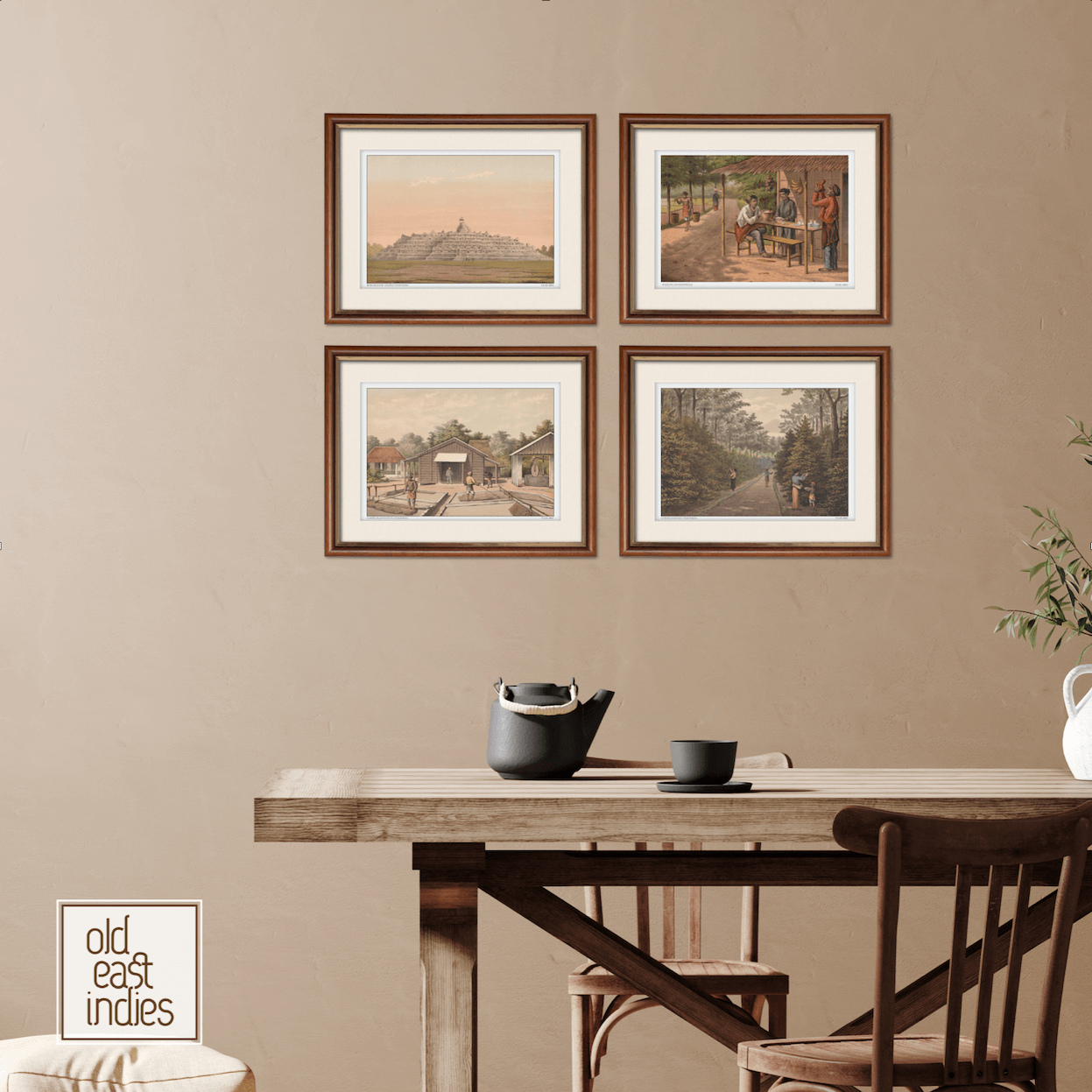Borobudur Temple Indonesia ~ Framed
Dating back to the 9th century, the Borobudur Temple complex is one of the defining landmarks of Buddhism in the Indies and one of the wonders of the world. Built in the style of a mandala, Borobudur consists of nine stacked platforms topped by a central dome. With 72 statues of the Buddha in its stupas, it is undoubtedly the largest buddhist temple in the world and a marvel. After the natives converted to Islam in the 14th century, the temple went in decline until Sir Stamford Raffles mounted an expedition to “rediscover” the lost temple. Originally published in the year 1883 by Cornelis Rappard, a colonel in the KNIL and a painter.
Jhr. Josias Cornelis Rappard (1824-1898) was a colonel in the KNIL and a painter. During his posting in the Netherlands Indies 1842-1872, he painted and drew pictures of life and scenes in the Indies that were later, back in Leiden, The Netherlands, would be made into chromolithographs. The Royal Tropical Institute in Amsterdam holds a large number of these prints and collectors all over the world appreciate Rappard's classic watercolours.
- Size 42.6 by 33.6 cm
- Quality Recycled Art Paper
- Mounted with Thick Art Cardboard
- Wooden Frame an Glass
- Description on the Back
Our framed art prints are printed on recycled uncoated speckled art paper and framed with eco-friendly wood.
Dating back to the 9th century, the Borobudur Temple complex is one of the defining landmarks of Buddhism in the Indies and one of the wonders of the world. Built in the style of a mandala, Borobudur consists of nine stacked platforms topped by a central dome. With 72 statues of the Buddha in its stupas, it is undoubtedly the largest buddhist temple in the world and a marvel. After the natives converted to Islam in the 14th century, the temple went in decline until Sir Stamford Raffles mounted an expedition to “rediscover” the lost temple. Originally published in the year 1883 by Cornelis Rappard, a colonel in the KNIL and a painter.
Jhr. Josias Cornelis Rappard (1824-1898) was a colonel in the KNIL and a painter. During his posting in the Netherlands Indies 1842-1872, he painted and drew pictures of life and scenes in the Indies that were later, back in Leiden, The Netherlands, would be made into chromolithographs. The Royal Tropical Institute in Amsterdam holds a large number of these prints and collectors all over the world appreciate Rappard's classic watercolours.
- Size 42.6 by 33.6 cm
- Quality Recycled Art Paper
- Mounted with Thick Art Cardboard
- Wooden Frame an Glass
- Description on the Back
Our framed art prints are printed on recycled uncoated speckled art paper and framed with eco-friendly wood.
Dating back to the 9th century, the Borobudur Temple complex is one of the defining landmarks of Buddhism in the Indies and one of the wonders of the world. Built in the style of a mandala, Borobudur consists of nine stacked platforms topped by a central dome. With 72 statues of the Buddha in its stupas, it is undoubtedly the largest buddhist temple in the world and a marvel. After the natives converted to Islam in the 14th century, the temple went in decline until Sir Stamford Raffles mounted an expedition to “rediscover” the lost temple. Originally published in the year 1883 by Cornelis Rappard, a colonel in the KNIL and a painter.
Jhr. Josias Cornelis Rappard (1824-1898) was a colonel in the KNIL and a painter. During his posting in the Netherlands Indies 1842-1872, he painted and drew pictures of life and scenes in the Indies that were later, back in Leiden, The Netherlands, would be made into chromolithographs. The Royal Tropical Institute in Amsterdam holds a large number of these prints and collectors all over the world appreciate Rappard's classic watercolours.
- Size 42.6 by 33.6 cm
- Quality Recycled Art Paper
- Mounted with Thick Art Cardboard
- Wooden Frame an Glass
- Description on the Back
Our framed art prints are printed on recycled uncoated speckled art paper and framed with eco-friendly wood.





